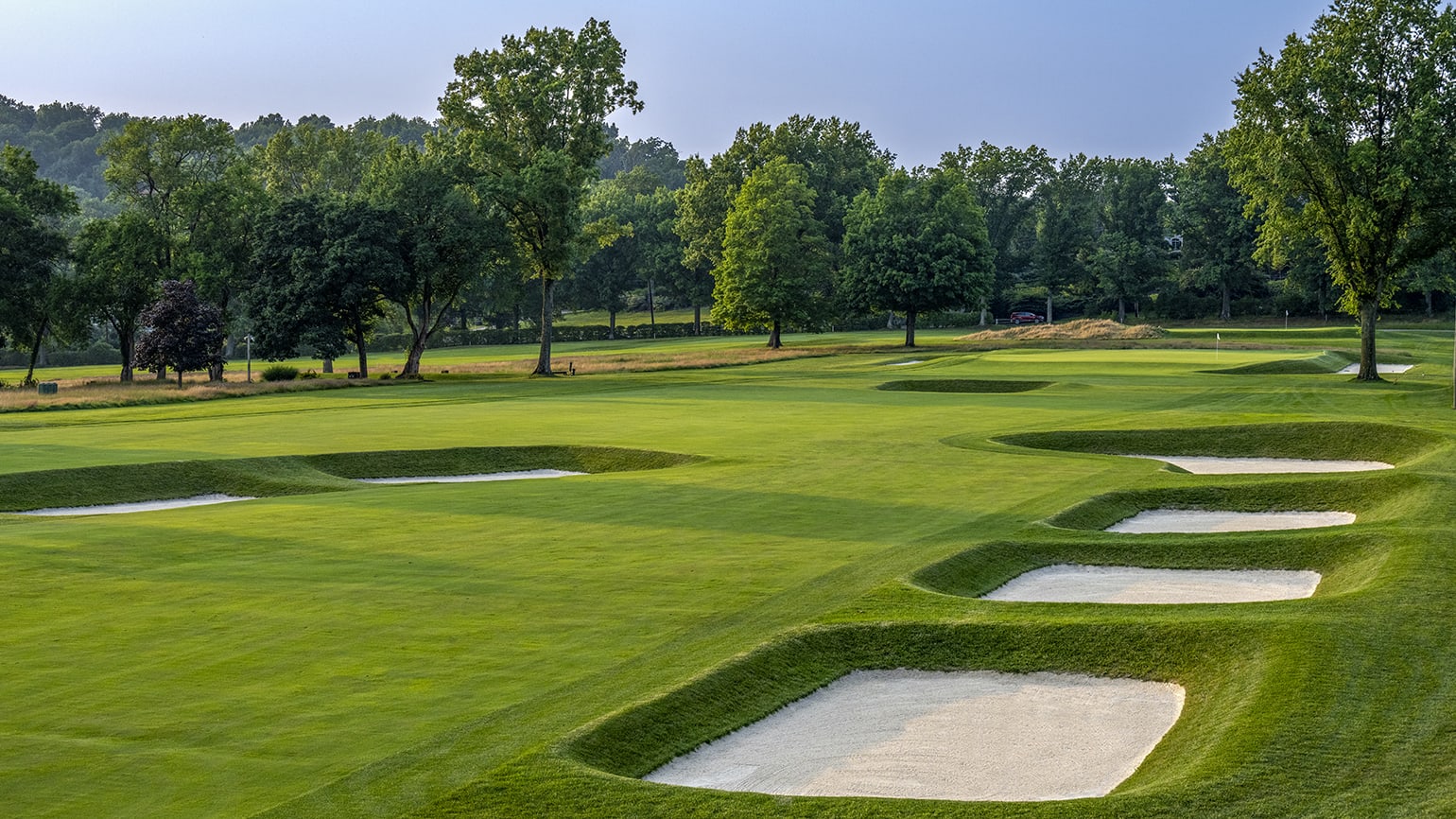Going to the Chapel
The USGA returns to Pittsburgh’s historic and delightful Fox Chapel G.C.
One of Jason Hurwitz’s first tasks after being hired as superintendent in 2006 at Fox Chapel Golf Club in Pittsburgh, host of the 2024 U.S. Senior Women’s Open, was far from glamorous. While cleaning out old agronomy equipment from a barn built prior to the club’s founding in 1923, Hurwitz ventured up a ladder into the hayloft, where he uncovered a dusty old box.
“My jaw just about hit the floor when I opened it,” Hurwitz recalled. “There was a stack of
documents, including a blueprint of the property with red markings indicating a hand-drawn routing of the golf course.”
He had found a 1923 survey and topographic map of the property, and while those markings can’t be attributed to original course architect Seth Raynor, the document did rekindle an existing passion among club members to bring back as many elements as possible of Raynor’s work. A restoration project completed four years ago achieved that goal, which means that the U.S. Senior Women’s Open will again be contested on a Raynor-designed course, as it was during the inaugural championship in 2018 at Chicago Golf Club.
The championships add to the considerable legacy of Raynor, an engineer and surveyor who came to golf architecture in his 30s after working on the National Golf Links of America in New York with Charles Blair Macdonald. Not being a golfer himself, everything the New York native learned about creating a course was absorbed directly from Macdonald, who patterned his designs around the concept of what he called “ideal” golf holes.
“It was never a copy of a certain hole – rather, Macdonald adapted holes to the terrain,” said Anthony Pioppi, a Connecticut-based Raynor historian. “But he believed there were certain tenets and principles of a good hole that Raynor learned and grasped. You can tell that because some of Raynor’s best holes were what he referred to as ‘natural.’ It wasn’t an ideal hole, it was one that fit the land. There’s a preferred way to play it, but there’s room for everyone to play it, too.”
Fox Chapel is home to a full menu of these ideal holes, with names like Eden, Leven and Redan, all familiar to course architecture aficionados now as “template” holes. Perhaps the most notable is the par-3 17th, a modern version of a Biarritz featuring an almost 90-yard-long green bisected by a 4-foot deep swale. Except that, according to Pioppi, Raynor and Macdonald never used the word template.
“That’s a modern description of their holes,” Pioppi said. “It makes sense and gives you the idea that these were repetitive concepts, but it has now turned into a template simply being a copy. It’s not. It’s about adapting to the site. Raynor’s work was anything but cookie-cutter.”
The author of highly regarded course designs at Fishers Island Club in New York, Yale University in Connecticut, 2019 U.S. Women’s Open host the Country Club of Charleston (S.C.), Shoreacres in Illinois, and the Camargo Club in Ohio, Raynor never saw his completed design at Fox Chapel. (The name came from an area landowner named Fox and the presence of a small church a mile from the club’s property). Raynor passed away at age 51, just seven months after the course debuted on June 13, 1925 – and his work there was notably altered by A.W. Tillinghast, who visited the club in 1935.
Still, over the ensuing decades the club hosted many notable events, including the 1965 U.S. Senior Amateur and the 1985 U.S. Women’s Amateur, when Michiko Hattori became the first player from Japan to win a USGA championship. The Senior Players Championship was conducted at Fox Chapel from 2012-14, with winners including Bernhard Langer and Kenny Perry.
The club’s signature moment in championship golf, however, came on the final day of the 2002 Curtis Cup Match. That’s when area native and seven-time USGA champion Carol Semple Thompson stood on the 18th green facing a 27-foot putt that could clinch the win for the USA.
“You know what I remember?” she said of the moment that capped off her record 12th and final Curtis Cup appearance. “Talking to my caddie while we were trying to line up the putt, I looked across the green. I saw a man with a blue cast on his lower leg. I said to my caddie, ‘I think I’m going to aim for that cast over there.’ He said, ‘Yeah, that looks like a good line.’ I hit it right on line and it just barely dribbled in the hole.”
The World Golf Hall of Fame member first played the course as a teenager in the early 1960s. “Fox Chapel is one of my favorite golf courses in Western Pennsylvania,” she said. “It’s a terrific course for women’s competitions and also a terrific spectator course because it’s fairly compact.”
It’s also part of a strong roster of courses in the area, led by nine-time U.S. Open venue Oakmont Country Club (a few miles east across the Allegheny River) along with the Longue Vue Club (the stroke-play co-host for the 2021 U.S. Amateur at Oakmont), Pittsburgh Field Club, Sewickley Heights Golf Club and Allegheny Country Club, which is Thompson's home club where she has won two USGA titles.
After playing in the U.S. Senior Women’s Open three times, Semple Thompson also understands just how much it means to competitors. “I think the pros and amateurs are thrilled with this championship,” said Semple Thompson, who received a special exemption from the USGA to compete in this year's championship. “It’s like a big reunion. It’s so much fun to see faces from years ago.”
This year’s competitors will face a course now much closer in look and feel to what Raynor originally laid out. In the late 1990s, Brian Silva began the process by incorporating Raynor-like features, and in 2015, Fazio Design was hired to prepare a master plan. Tom Marzolf led that restoration process, working closely with Hurwitz and using archival aerial photos to create what the duo referred to as a “sympathetic restoration.”
“Our intention was to restore every possible aspect of Raynor features on the property but do it in a manner sympathetic to the modern game,” said Hurwitz, who departed Fox Chapel last year. The project took place in 2019 and 2020, and included repositioning bunkers, lessening the degree of slope in greenside bunker walls, and returning a “Lion’s Mouth” bunker to the front edge of the ninth green.
“We have tried to maintain a lot of the geometry in the course,” said James “Lock” Walrath, the club’s general chairman of the 2024 U.S. Senior Women’s Open. “The bunkers are very geometric, almost to the extreme. We chose that as a design feature in homage to Raynor, who was known as ‘The Engineer.”
As for that document uncovered by Hurwitz in the hayloft 17 years ago? It was sent to the USGA for safekeeping. But a framed replica hangs on the clubhouse’s Grill Room wall. Nearly 100 years after golfers first roamed his skillfully crafted fairways and greens, Raynor’s spirit remains alive at Fox Chapel.
Tom Mackin is an Arizona-based freelance writer whose work regularly appears in Golf Journal and the USGA website.
This content was first published in Golf Journal, a quarterly print publication exclusively for USGA Members. To be among the first to receive Golf Journal and to learn how you can help make golf more open for all, become a USGA Member today.
















